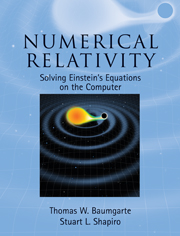Book contents
- Frontmatter
- Contents
- Preface
- Suggestions for using this book
- 1 General relativity preliminaries
- 2 The 3 + 1 decompostion of Einstein's equations
- 3 Constructing initial data
- 4 Choosing coordinates: the lapse and shift
- 5 Matter sources
- 6 Numerical methods
- 7 Locating black hole horizons
- 8 Spherically symmetric spacetimes
- 9 Gravitational waves
- 10 Collapse of collisionless clusters in axisymmetry
- 11 Recasting the evolution equations
- 12 Binary black hole initial data
- 13 Binary black hole evolution
- 14 Rotating stars
- 15 Binary neutron star initial data
- 16 Binary neutron star evolution
- 17 Binary black hole–neutron stars: initial data and evolution
- 18 Epilogue
- A Lie derivatives, Killing vectors, and tensor densities
- B Solving the vector Laplacian
- C The surface element on the apparent horizon
- D Scalar, vector and tensor spherical harmonics
- E Post-Newtonian results
- F Collisionless matter evolution in axisymmetry: basic equations
- G Rotating equilibria: gravitational field equations
- H Moving puncture representions of Schwarzschild: analytical results
- I Binary black hole puncture simulations as test problems
- References
- Index
Suggestions for using this book
Published online by Cambridge University Press: 05 March 2013
- Frontmatter
- Contents
- Preface
- Suggestions for using this book
- 1 General relativity preliminaries
- 2 The 3 + 1 decompostion of Einstein's equations
- 3 Constructing initial data
- 4 Choosing coordinates: the lapse and shift
- 5 Matter sources
- 6 Numerical methods
- 7 Locating black hole horizons
- 8 Spherically symmetric spacetimes
- 9 Gravitational waves
- 10 Collapse of collisionless clusters in axisymmetry
- 11 Recasting the evolution equations
- 12 Binary black hole initial data
- 13 Binary black hole evolution
- 14 Rotating stars
- 15 Binary neutron star initial data
- 16 Binary neutron star evolution
- 17 Binary black hole–neutron stars: initial data and evolution
- 18 Epilogue
- A Lie derivatives, Killing vectors, and tensor densities
- B Solving the vector Laplacian
- C The surface element on the apparent horizon
- D Scalar, vector and tensor spherical harmonics
- E Post-Newtonian results
- F Collisionless matter evolution in axisymmetry: basic equations
- G Rotating equilibria: gravitational field equations
- H Moving puncture representions of Schwarzschild: analytical results
- I Binary black hole puncture simulations as test problems
- References
- Index
Summary
Our book is intended both as a general reference for researchers and as a textbook for use in a formal course that treats numerical relativity. We envision that there are at least two different ways in which the book can be used in the classroom: as the main text for a one-semester course on numerical relativity for students who have already taken an introductory course in general relativity, or as supplementary reading in numerical relativity at the end of an introductory course in general relativity. There may be more material in the book than can be covered comfortably in a single semester devoted entirely to numerical relativity. There certainly is more material than can be integrated into a supplementary unit on numerical relativity in an introductory course on general relativity.
The latter may be true even when such a course is taught as a two-semester sequence, if the course is already broad and comprehensive without numerical relativity. There are several ways to design a shortened presentation of the material in our book without sacrificing the core concepts or interfering with the logical flow. The amount of material that must be cut out from any course depends, naturally, on the amount of time that is available to devote to the subject. One means of reducing the content while retaining the fundamental ideas in a self-contained format is to restrict the discussion to pure vacuum spacetimes, i.e., spacetimes with no matter sources.
Information
- Type
- Chapter
- Information
- Numerical RelativitySolving Einstein's Equations on the Computer, pp. xvii - xviiiPublisher: Cambridge University PressPrint publication year: 2010
